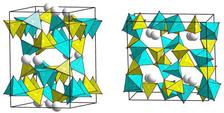The crystal structure of the feldspar anorthite under normal conditions (left) and the newly discovered high-pressure variant (right). Under normal conditions, the silicon and aluminium atoms form tetrahedra (yellow and blue) with four oxygen atoms each (red). Under high pressure polyhedra with five and six oxygen atoms are formed. Calcium atoms (grey) lie in between. The black lines outline the so-called unit cell, the smallest unit of a crystal lattice. (Credit: DESY, Anna Pakhomova)
In high-pressure experiments at PETRA III, scientists have discovered new forms of the common mineral feldspar. At moderate temperatures, these hitherto unknown variants are stable at pressures of Earth's upper mantle, where common feldspar normally cannot exist. The discovery could change the view at cold subducting plates and the interpretation of seismologic signatures, as the team around DESY scientist Anna Pakhomova and Leonid Dubrovinsky from Bayerisches Geoinstitut at the University of Bayreuth report in the journal Nature Communications.
Feldspars represent a group of rock forming minerals that are highly abundant on Earth and make up roughly 60 per cent of Earth’s crust. The most common feldspars are anorthite (CaSi2Al2O8), albite (NaAlSi3O8), and microcline (KAlSi3O8). At ambient conditions, the aluminium and silicon atoms in the crystal are each bonded to four oxygen atoms, forming AlO4 and SiO4 tetrahedra.
“The behaviour of feldspars under increasing pressure and temperature has been intensively investigated before, with respect to their fate in Earth’s interior,” explains Pakhomova. “Feldspars are known to be stable only at pressures of up to 3 Giga-Pascals (GPa) along the common pressure-temperature profile of the Earth, while they decompose into denser minerals at higher pressures.” 3 GPa are equivalent to 30,000 times the normal air pressure at sea level. “However, under cold conditions feldspars may persist metastably at pressures higher than 3 GPa,” adds Pakhomova. “Previous high-pressure structural studies of feldspars at room temperature have shown that the tetrahedral framework of feldspars is preserved up to 10 GPa.”
The scientists now subjected common feldspars to pressures of up to 27 GPa and analysed their structure at the Extreme Conditions Beamline P02.2 of DESY's X-ray light source PETRA III and at the Advanced Photon Source (APS) in Chicago. “At pressures above 10 GPa, we have discovered new high-pressure polymorphs of anorthite, albite and microcline,” reports Pakhomova. “The phase transitions are induced by severe geometrical distortions of AlO4 and SiO4 tetrahedra, which result in the aluminium and silicon atoms gaining additional neighbouring atoms and also in the formation of denser frameworks based on polyhedra where one aluminium or silicon atom is bonded to four, five or six oxygen atoms.”
To investigate the stability of the discovered high-pressure variants of feldspars at high temperatures and their possible persistence in Earth’s interior, the scientists performed a series of high-pressure-high-temperature experiments at the Bayerisches Geoinstitut. It turned out that the high-pressure variant of anorthite persists at temperatures up to 600 degrees Celsius at 15 GPa.
“Such pressure-temperature conditions could be found on Earth in the subductions zones – regions where two lithospheric plates collide, one riding over the other,” explains Dubrovinsky. “In such geological settings, feldspars are delivered into Earth’s interior along with other crustal material by the descending plate. Our results indicate that in cold subduction zones, if the temperature does not rise above 600 degrees, high-pressure phases derived from feldspars could persist at depths corresponding to Earth's upper mantle. This could possibly influence the dynamics and fate of cold subducting lithospheric plates and alter seismological signatures.”
Scientists from the University of Bayreuth, Saint Petersburg State University, the University of Chicago, and DESY contributed to this research.
(from DESY News)
Reference:
Polymorphism of feldspars above 10 GPa; Anna Pakhomova, Dariia Simonova, Iuliia Koemets, Egor Koemets, Georgios Aprilis, Maxim Bykov, Liudmila Gorelova, Timofey Fedotenko, Vitali Prakapenka, Leonid Dubrovinsky; Nature Communications, 2020; DOI: 10.1038/s41467-020-16547-4







